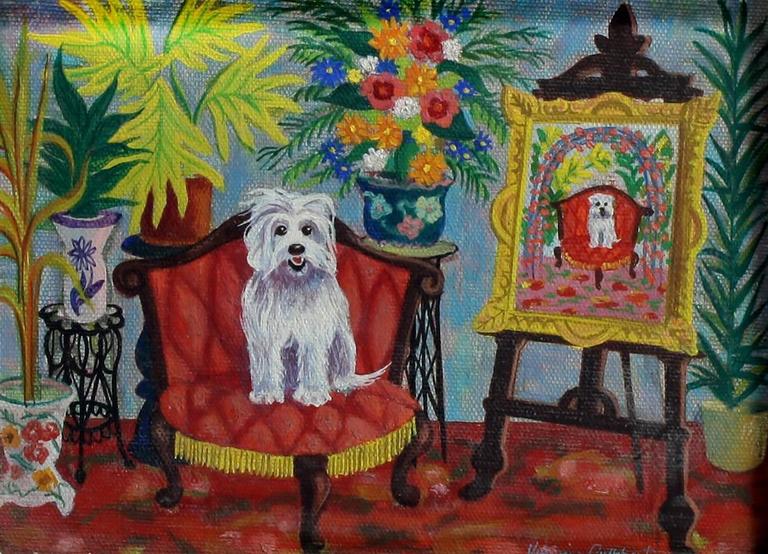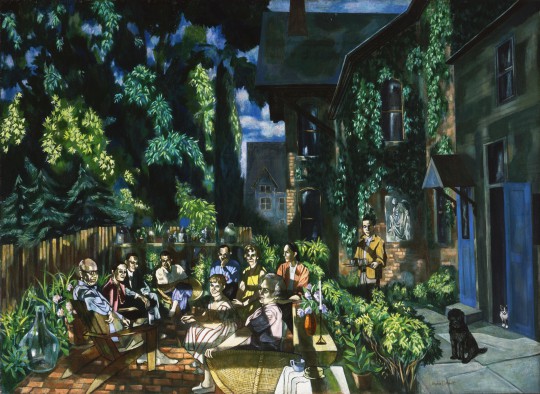Virginia Cuthbert • American (1908-2001)
Nantucket Landscape C: 1963/64 • Oil on Canvas 38" x 51"
Virginia Cuthbert was raised by two arts-loving parents; one loved music and the other, art. When she was five, her musician mother began teaching her to play the piano. At six, she began to paint, pleasing her minister father. She both painted and played the piano, through most of her life, but only one led her on a twisted path from a small town in western Pennsylvania to Paris, New York and, finally, Buffalo.
As Virginia Cuthbert once told the Smithsonian: “Heart came ahead of anything. Art came ahead of music.”
Let’s talk about the heart. After graduating from Syracuse University, and a brief sojourn in Provincetown at the tip of Cape Cod, she journeyed to London, Florence and, finally, Paris. On her second day in Paris she met Philip Elliott, a young painter from Buffalo, New York. They married in 1935 and remained so for over 50 years. He led her back to America, first to New York City, then to Pittsburgh, and finally back to his native Buffalo, the city they are most closely associated with.
A natural storyteller, she was further inspired by Ash Can painter, George Luks. Ash Can artists were realists dedicated to telling the stories of America’s increasingly urban life. Their emphasis on themes of alienation, isolation, and poverty made them somewhat provocative in their day.
(story continues below break)
INTERESTING STORIES FROM OUR SPONSORS

When Cuthbert began studying with Luks at his New York school she was already predisposed to capturing the essence of a place using her watercolor and oil paints. Later in life she also experimented with elements of Surrealism and Magic Realism.
She and Elliot moved to Buffalo in 1942 when Elliott was named head of the Albright School of Art. There they remained for the rest of their lives with Cuthbert becoming the grand dame of the area’s art scene.
Her other great life’s passion was alcohol, and her alcoholism is most likely why she produced so many fewer paintings than her contemporaries. Alcohol is certainly part of the reason she suffered a major stroke in 1987, two years after her husband died. You can hear the effects in her oral history on the Smithsonian’s Archives of American Art. Her speech was slurred and words came with great effort.
However, even alcohol could not totally come ahead of painting. Though physically weakened, she continued to paint for over a decade after her stroke. In the end, with her husband dead, alcohol put aside, and no longer able to play the piano, Virginia Cuthbert remained a painter.
Canton Museum of Art Permanent Collection
Purchased with a Matching Fund Grant from the National Endowment for the Arts, 73.24
4 Ways to Sound Smart When Viewing at The Canton Museum of Art
1.
“Her father, a minister, was a 4th generation religious leader who also loved art and passed this appreciation on to his daughter.”
2.
“She lived the ‘American in Paris’ story, falling in love with the man who became her husband on her second day in Paris.”
3.
“Unfortunately she had problems with alcohol. This made her far less productive than her contemporaries and eventually led to a major stroke.”
4.
“She was heavily influenced by Ash Can School artists who captured the alienation and loneliness of industrial America, though she often added a Surrealist twist to her compositions.”
Cuthbert Timeline. Scroll over images to see timeline.
























